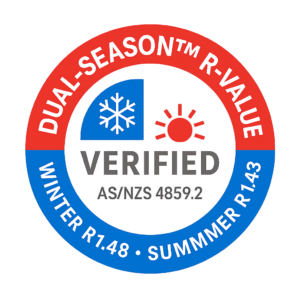
Peter is a licensed builder with over 45 years of experience in the construction industry. In 2012, his expertise in energy efficient construction inspired the invention of ThermaDoor Premium garage door insulation - the original purpose made garage door insulation in Australia.
Most companies selling various insulation materials as garage door insulation quote a single R-value. However, in Australia, dual-season, assembly calculated R-values are what truly matter under the correct Australian Standards.
This guide explains how to spot properly calculated, garage door specific R-values, why installation practice and door performance matter, and how accurate inputs can support NatHERS modelling under the National Construction Code (NCC) 2022 for new builds.
We’ll compare materials, including ThermaDoor Premium garage door insulation, clarify the role of air gaps and spring balance, and give you a buyer’s checklist so you are supported to ask the right questions when considering investing in garage door insulation – for comfort, compliance and real energy savings.
An R-value measures resistance to heat flow. Generally speaking, the higher the R-value the better thermal resistance. But here’s the catch:
Many products currently being sold as garage door insulation quote R-values from wall or ceiling tests or material R-values (sometimes referred to as standalone R-values). These quoted numbers don’t translate to a thin steel, moving, air-leaky garage door. System and assembly effects such as thin steel skins, thermal bridging, perimeter air paths and solar/radiant load, must be accounted for when determining a garage door’s effective R‑value.
The best R-value is an independently calculated, garage door specific value that is backed by thermal engineering reports. ThermaDoor Premium is the original and still the ONLY PURPOSE MADE garage door insulation. We publishe R1.48 (winter) / R1.43 (summer), calculated by a thermal engineer under AS/NZS 4859.1 & 4859.2:2018 (the standards referenced by NCC 2022). Wall, floor and ceiling values or material (standalone) values don’t translate to thin, moving steel doors.
Insulating your garage door stops one of the biggest, leakiest surfaces in your home from behaving like a giant radiator in summer and an ice pack in winter. A bare metal door soaks up heat and cold, then dumps it straight into the rooms beside or above the garage – driving up energy use and making living areas uncomfortable. Proper garage door insulation:
Less heat flow, lower bills, quieter environment, happier humans
Before you buy, it’s just as important to understand what happens when the numbers aren’t verified for garage doors. Using wall, ceiling or ‘standalone’ R-values – or products not purpose made for a thin steel, moving, air-leaky garage door can undermine thermal performance, create condensation risks and complicate NCC 2022 compliance and NatHERS modelling for new builds. The result can be a door that looks insulated on paper but under delivers in the real world.
Curious why garage doors are considered R0.0? Learn more in our blog: Why Garage Doors Have an R-Value of Zero – And How to Fix it
Choosing the wrong product – or the right product verified in the wrong application – can cost you comfort, compliance and money. Here’s what commonly goes wrong when garage doors are insulated with generic wall or ceiling products or with R‑values not derived from proper testing in the garage door.
For new home builds, using wall or ceiling R‑values for a thin steel, moving, air‑leaky garage door skews modelling inputs. That can tip a new build below 7‑Star NatHERS goals, trigger redesigns and delay approvals.
Metal skins, thermal bridging, perimeter air paths and radiant/solar load change how insulation behaves. A headline R‑value from a plasterboard wall test or a ‘standalone’ R-value, won’t translate to the effective garage door R‑value, so summer heat and winter cold still pours into your garage space and bleeds into adjacent rooms.
Sticking insulation hard against the door can remove the necessary air gap for reflective surfaces and trap moisture on the steel. Over time that can promote mould growth, odours and rust – especially in cool or coastal climates.
Adding any additional weight without spring re‑balancing strains motors and openers, increases wear and may take the door outside Australian Standards performance expectations. Relying on glue alone can lead to panels sagging, detaching or jamming the door.
Moisture affected or poorly supported products lose thickness, delaminate and need early replacement. Paying twice – first for the wrong solution, then to fix it – wipes out any perceived upfront ‘savings’.
A purpose‑made garage door insulation with independently determined R‑values specific to the garage door. Installed to relevant Australian principles (maintain position/thickness and manage condensation), while keeping the door within operational expectations (including spring re‑balancing). That’s how you get the best R‑value for garage door insulation where it actually counts—on the door itself—and support accurate NatHERS modelling under NCC 2022.
ThermaDoor offers both supply and installation and DIY garage door insulation kits designed specifically for Australian panel lift and tilt doors – with verified dual-season R-values for NCC 2022 compliance.
Important Note:
Imperial ratings – Some suppliers list American imperial R-values, which are not equivalent to Australian metric R-values. Watch out for these as they appear much higher on paper than Australian R-values – there is no simple way to convert these to the correct R-values for Australia.
Published technical data from GPS manufacturers shows it provides about 10–20% lower thermal conductivity than white EPS of the same density, so you can achieve similar thermal value at reduced thickness. It also provides a modern grey aesthetic that some appreciate.
PIR is a type of foam board that is typically faced with foil on both sides. This heavy, rigid product is known for its thermal insulation capabilities (R-value) when used in commercial and residential construction such as wall cavities, roofs, and the underside of suspended car parks.
Open cell insulation products are soft, breathable blankets you’d normally find tucked inside framed walls or ceilings. They include polyester acoustic boards and blankets, fibreglass batts, and other fluffy, air permeable bulk materials. They are effective at insulating or in the case of acoustic panelling – soaking up noise. These products need to be kept dry and were intended to be used in lined, enclosed spaces such as walls and ceilings.
Reflective foil insulation is a thin, low‑emissivity aluminium laminate that works by reflecting radiant heat across an adjoining still air space rather than by trapping heat. Without an adjacent air gap, the reflective contribution to R‑value is greatly reduced. It was originally developed as roof and wall sarking (and duct wrap) to act as a radiant barrier in these applications.
Established in 2012, ThermaDoor Premium is Australia’s original and still the only purpose made garage door insulation. It has a construction grade polystyrene core, a laminated, tough, easy clean white vinyl face and a laminated construction grade sisalation foil backing (the material your house is wrapped in for thermal protection). ThermaDoor Premium’s thermal performance is independently determined in line with AS/NZS 4859.1:2018 and applied to the garage door assembly per AS/NZS 4859.2:2018 (See more below).
It’s not just about having insulation – it’s about having insulation that performs where it counts. ThermaDoor is built for garage doors, and that’s what sets us apart.
Australian Standards are nationally agreed technical rules, developed by Standards Australia with industry experts, government and consumers, that set minimum requirements for safety, performance and quality. They matter because they give everyone a common rulebook – manufacturers know what to make, installers know how to do it, regulators can enforce compliance and homeowners get products that actually perform as promised. Many of these standards are referenced (or ‘called up’) in legislation like the National Construction Code, so following them isn’t just best practice – it’s often a legal obligation (See NCC 2022 overview).
This standard sets the engineering baseline for garage doors: wind loading, structural strength, safe operation, fixings and installation tolerances. It doesn’t tell you how to insulate – it tells you what the door must do after you add anything to it. Any retrofit must not take a door out of 4505 compliance (including safe, balanced operation); spring re‑balancing by a qualified technician is recommended whenever weight is added.
This standard covers how bulk insulation is installed in residential buildings, including general installation, maintaining position and thickness, electrical safety, and provides guidance relevant to condensation risk. It does not contain a universal ‘no glue’ rule and does not specifically mention garage doors; however, in a high‑movement assembly like a garage door, mechanical support is best practice to maintain thickness and position and preserve any required air gap.
This is the Australian-New Zealand standard that sets out how insulation products must be tested, calculated and labelled so R-values are accurate, consistent, and comparable. It governs everything from the way thermal resistance is measured to how results are declared in packaging and marketing. The 2024 amendment tightened key clauses and updated calculation tables to reduce the risk of inflated or misleading performance claims.
Part 2 works alongside Part 1 but focuses on calculating the R-value for the entire building element or system – in this case, the full garage door assembly once insulation is installed. It requires separate winter (15 degrees) and summer (30 degrees) values to reflect how performance changes with temperature. This dual-season approach is essential for compliance with the National Construction Code (NCC) and NatHERS energy ratings for new homes, ensuring the numbers reflect real world conditions. Part 2 provides clear and concise requirements for determination and reporting of R-values and system R-values to promote greater consistency of these calculations within the Australian and New Zealand marketplaces.
These standards mean any garage door insulation worth considering should have R-values determined to both AS/NZS 4859.1:2018 and AS/NZS 4859.2:2018 — not estimated, not material or ‘standalone’, and not borrowed from unrelated applications like walls and ceilings — so you can trust that the number you see is the performance you’ll get.
Garage doors are typically constructed from steel, which is non-combustible. Therefore, the steel door itself provides the fire resistance. The insulation behind it is a bulk thermal product – its role is comfort and energy efficiency, not structural fire protection. Therefore Australia’s National Construction Code does not require the insulation to carry a fire rating.
It does however require insulation to be fire-retardant and tested under the correct Australian Standard – AS 1530.2.
This article, Fire Rating and Garage Door Insulation Explained provides in-depth information about garage door insulation and fire safety.
The National Construction Code (NCC 2022) lifts energy‑efficiency performance for new homes (commonly expressed as the “7‑Star” pathway) and strengthens condensation management. While garages aren’t always conditioned, their thermal behaviour influences adjacent rooms. Using verified, assembly‑appropriate inputs allows assessors to model the real benefit of an insulated garage door in NatHERS where applicable.
The NatHERS program turns construction details into a star rating. Accurate, documented inputs (e.g., independently verified, garage door specific R‑values) help assessors avoid default assumptions and reflect the true performance of an insulated garage door.
Condensation builds up quickly on metal garage doors, especially in cooler or coastal climates. Without an air cavity, insulation can trap moisture, which leads to mould, rust, and structural damage over time. Design to manage condensation risk using ABCB guidance. (NCC 2022 condensation provisions; ABCB Condensation in Buildings Handbook).
The air cavity can act as a secondary thermal layer and, for reflective surfaces, an adjacent still air space is required for the reflective R‑value contribution – compressing or gluing tight to metal removes this benefit.
Standards emphasise maintaining insulation position and thickness. In a moving assembly such as a garage door, mechanical support helps preserve thickness and any required air space.
Maintaining a small air gap also allows the door skins to expand/contract naturally and helps keep the modified door within its performance expectations under AS/NZS 4505.
Think of it like a chain: break one link (unverified R-values, sloppy install, overloaded door) and the whole ‘compliance chain’ falls apart.
Significant research and development have gone into ThermaDoor Premium garage door insulation so we can be sure we are bringing you the best, purpose made garage door insulation on the Australian market.
Heat doesn’t move the same way year‑round. AS/NZS 4859.1:2018 (declaration) and AS/NZS 4859.2:2018 (application) recognise directional heat flow. ThermaDoor is determined in both directions of heat flow, so we publish R1.48 (winter) and R1.43 (summer). Many brands quote a single headline number—often from wall or ceiling tests or a ‘standalone’ number —so it doesn’t reflect how insulation actually performs in a metal garage door.
ThermaDoor is (based on our August 2025 market review) the only Australian garage door insulation brand that publishes dual-season, door assembly R-values under AS/NZS 4859.2:2018. By declaring real world performance for the whole door (not just the material) and backing it with independent engineering and a purpose-built design for sectional and tilt doors, we make it easy to choose with confidence – verified, clear numbers, comfort all year round and no guesswork.
Two R-values = transparent, season specific performance you can trust.

Insulating a metal garage door can deliver real comfort and efficiency—but only when the numbers are verified for the door assembly and the installation preserves how the door is engineered to work.
R‑values must be door specific. Material declarations under AS/NZS 4859.1:2018 are the start. Applying them to the actual garage‑door assembly per AS/NZS 4859.2:2018 makes the number meaningful.
Installation quality is critical. Maintain an air gap for reflective surfaces, use mechanical support, and re‑balance springs so the door stays within AS/NZS 4505 expectations. Manage condensation in cool, coastal climates.
Compliance is a pathway, not a label. Products don’t “meet the NCC” in isolation; buildings do. Provide door specific inputs so your assessor can model the real benefit in NatHERS for new builds.
If you require a copy of our thermal rating documentation, we invite you to contact us.
At ThermaDoor we want you to do your own research and come back to us with the hard questions. But to get you started, we have created a Buyers Checklist that will assist you to ask the correct questions when shopping around for garage door insulation.
Aim for at least R1.3 that’s determined for garage doors (not walls, floors, ceilings or ‘standalone’ numbers) under AS/NZS 4859.1:2018 and applied to the garage door under AS/NZS4859.2: 2018.
Two-way values are ideal. Example: ThermaDoor Premium R1.48 (winter) / R1.43 (summer) – suitable for NatHERS modelling and NCC 2022 goals for new homes.
No. A garage door is a thin steel, moving assembly with perimeter air paths and high radiant load. Those conditions change conduction, convection and radiation, so wall and ceiling R-values overstate performance on a garage door. Use numbers verified for garage door assemblies per AS/NZS 4859.1:2018 & 4859.2:2018.
The material R-value only tells you the products R-value on its own. It doesn’t give you the big picture of how well it insulates in the garage door. Due to the unique nature of a garage door – metal, air leakage, thermal bridging – a garage door will more often reduce the material (standalone) value quoted.
Yes. A small air cavity improves the system R-value, helps control condensation and lets the door skin expand and contract safely. Avoid glue-on installs that press insulation to bare metal; choose mechanical fixing that preserve the gap and aligns with AS 3999 practices.
Not if it’s lightweight, mechanically fixed and the springs are re-balanced. A typical 16 panel door fitted with ThermaDoor Premium adds about 7kg. A technician should adjust springs, so the door remains balanced and within its AS/NZS 4505 performance expectations.
For DIY garage door insulation kits, we recommend you contact a suitably qualified garage door technician to do this for you.
Definitely and you should! Ask the supplier for a thermal engineer’s report outlining methodology under AS/NZS 4859.1&2:2018. If the supplier can’t provide their door specific documentation, treat the claim as unverified marketing spin.
Go here for more Garage Door Insulation Frequently Asked Questions
1. Standards Australia – AS/NZS 4859.1:2018 – Thermal insulation materials for buildings – Part 1: General criteria and technical provisions.
Defines how insulation material R-values must be measured and reported in Australia.
View Standard
2. Standards Australia – AS/NZS 4859.2:2018 – Thermal insulation materials for buildings – Part 2: Design.
Explains how to calculate assembly/system R-values, including separate winter and summer figures for compliance.
View Standard
3. Standards Australia – AS/NZS 4859.1:2018 Amendment 1:2024 – Latest updates to AS/NZS 4859.1.
Introduces changes to clauses and tables, ensuring the most accurate and current R-value reporting.
View Amendment
4. Australian Building Codes Board (ABCB) – National Construction Code (NCC) 2022
Mandates compliance with AS/NZS 4859.1 & 4859.2 for insulation products to meet national energy efficiency standards.
View NCC
5. Nationwide House Energy Rating Scheme (NatHERS)
Government program that measures a home’s thermal performance, using verified R-values to support NCC compliance and star ratings.
Visit NatHERS

Call, text, or send an enquiry below to see if we have an installer in your area.
"*" indicates required fields